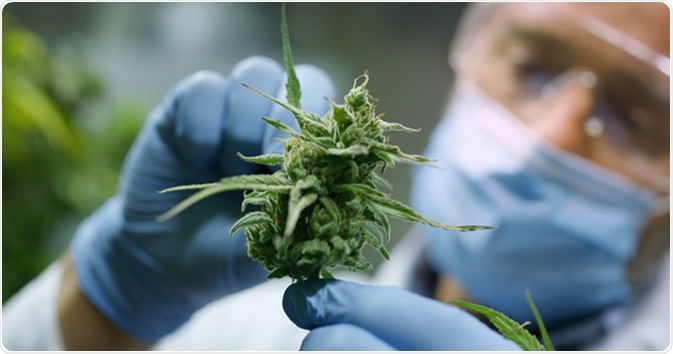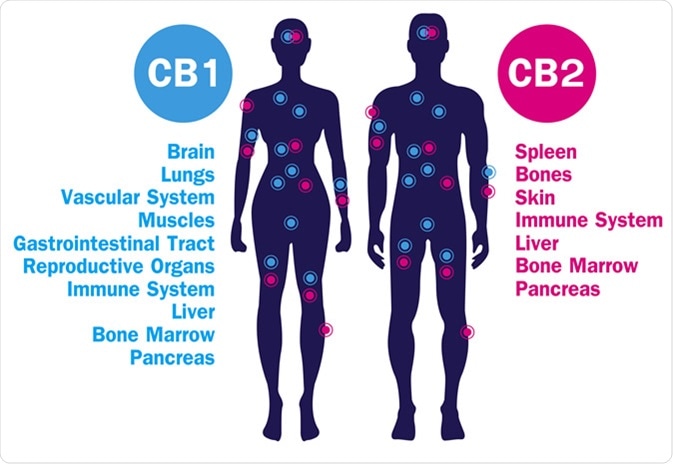Skip to:
What is CBD?
CBD, or cannabidiol, is an active compound extracted from the cannabis plant. It is only one of many chemicals extracted from this plant, but is distinctive in that it doesn’t produce psychiatric symptoms or intoxication. Studies in animals suggest that CBD relieves pain and inflammation, but confirmation from animal studies is lacking. However, many people continue to report their experiences of pain and anxiety reduction, and better sleep, with CBD.

Image Credit: HQuality / Shutterstock
CBD derived from hemp plants is legal, since these plants contain 0.3% or less of tetrahydrocannabinol, the mind-altering substance for which marijuana is famous. However, it is important to know that CBD from any plant in the cannabis species has the same structure and actions irrespective of its origin, and the sourcing is an issue mainly because of the legal issues surrounding marijuana use in some States in the US, and in many countries of the world. Most CBD is derived from the industrial hemp plant which has higher concentrations of this chemical. The oil is extracted by one of many methods and then added to a carrier oil to form CBD oil.
What does CBD do to the body?
It is intriguing that each major pain system has first come to light because scientists were looking into natural pain relievers, namely, such as the endorphin system from studying the opium poppy, the endocannabinoid system from the study of cannabis, capsaicin from Chile peppers, and the inflammatory cascade through the study of salicylic acid (the basis of aspirin, the first NSAID) from willow bark.
The human body produces chemicals very similar to cannabinoids, called endocannabinoids. These are produced only when required, and act at certain nerve junctions to help the body do the following things: “relax, eat, sleep, forget and protect.” The endocannabinoid system, consisting of the endocannabinoids, their receptors and enzymes which act on them, act in parallel with other major pain systems such as the endorphin and inflammatory system.
The endocannabinoid system fires steadily to modulate pain signals. When inactivated in some animal experiments, the result was abnormal pain sensitivity. There are two types of receptor through which CBD operates, CB1 and CB2. Pain signals are inhibited via CB1 activation, and CB2 inhibits inflammation.
How does CBD relieve pain in arthritis?
CBD acts via the endocannabinoid system, which is active on receptors found in multiple areas of the brain, and at spinal cord level, to stop the transmission of pain signals. It is 10-times as active as morphine in its effect on certain types of pain nerve cells, and also produces pain relief in response to stress. It produces peripheral pain relief as well by stimulation of CB1 receptors. CBD is chemically very similar to endocannabinoids like anandamide, or arachidonoylethanolamine, and 2-arachidonoylglycerol, that bind to ECS receptors. It increases the levels of anandamide at high doses, producing pain relief.

Human endocannabinoid CB1 and CB2 Receptors target system active in human body. Image Credit: Wut.ti.kit / Shutterstock
CBD also has powerful antioxidant activity, said to exceed that of vitamin C or vitamin E. It is thus claimed to be the first endocannabinoid modulator to be used in patients to relieve pain. It is also a TNF-α inhibitor, but does not cause gastric irritation or increase the risk of vascular disease like NSAIDs because it does not act on either of the cyclooxygenase enzymes (COX-1 and COX-2) that are inhibited by NSAID action. It also increases adenosine signaling and thus reduces inflammation and produces pain relief.
Observed actions of CBD
When topically applied in gel form, CBD reduces inflammation and hypersensitivity in rats with arthritis, being well absorbed with little inactivation by the liver. The absorption is directly proportional to the amount applied, with a potentially lower risk of systemic symptoms and increased local levels of CBD. Joint swelling and other signs of joint inflammation were reduced with this treatment. With oral use, too, there is a significant reduction in pain sensation in rat experiments. There is less inflammation and a lower concentration of inflammatory molecules in and around the joint space, which leads to improvement of symptoms, as well as preventing joint cartilage breakdown over time.
During joint inflammation, synovial membrane cells that are responsible for producing lubricating joint fluid and helping with local immunity are activated and begin to secrete inflammatory chemicals including TNF-α, IL1-α and others. These increase the sensitivity of the primary pain receptors in the joints but also recruit other cells to enhance the production of these cytokines, increasing the intensity of inflammation. CBD application appears to desensitize this pain system, called TRPV1, thus stopping further pain and progression. Smoking cannabis is a commonly reported method to ease arthritis pain, and forms the single largest reason cited by patients for medical use of the drug. In the absence of clinical trials, it remains a promising treatment which should be pursued seriously.
Using CBD wisely
A 2017 study performed on behalf of the US National Academy of Sciences found that cannabinoids produced a higher chance of pain reduction in patients with chronic pain. They did not differentiate between THC, CBD, and other chemicals in cannabis.
Without high-quality clinical studies on CBD in arthritis, however, it is difficult to predict clinical benefit, to recommend dosages for various arthritic conditions, or any formulation. Different formulations begin to act at different intervals, and may contain other ingredients that act via other mechanisms to relieve pain or inflammation. For instance, pain-relieving CBD ointment could contain menthol or capsaicin as well, both of which are also good at reducing mild pain. This makes it hard to decide how much of the observed effect was actually due to CBD from anecdotal reports, as opposed to properly designed trials.
Quality check – absent
One of the biggest issues with the use of CBD is that you don’t know what you’re getting when you buy it. A largely unregulated market has resulted in misleading labels, inadequate or absent quality checks, and undisclosed contaminants or adulteration with THC, pesticides, solvents or metals, as well as wide variation in the strength of CBD. Thus it is safest to check the label to ensure that the company involved follows good manufacturing practices, and gets its products tested by methods compliant with the following: the American Herbal Pharmacopoeia (AHP), the U.S. Pharmacopeia (USP) or the Association of Official Agricultural Chemists (AOAC).
Dosage – unknown
The dosage of CBD in arthritis is far from clear, for the above reasons. Because CBD has not been evaluated for specific conditions at specific doses, it is not possible to give an evidence-based recommendation regarding safe doses. Because CBD is unregulated, sellers can make many claims about efficacy or offer dosing advise with no scientific evidence to support their claims.
Using CBD properly
Some practices are already widely agreed upon among medical professionals with respect to CBD:
- First review your purpose with your medical doctor so you can be sure you have tried all other reasonable options. This will also help you to objectively evaluate what benefit you are receiving from the CBD oil, which can come quite dear. CBD oil is provided as a capsule which is swallowed, or as a liquid which is added to food or water. It can also be rubbed directly on the skin over the affected joint. Orally taken CBD is absorbed in a variety of patterns, depending on whether there is food in the stomach, and may begin to act only after a couple of hours. It can also be taken by putting it under the tongue for 1-2 minutes, which speeds up the effect, causing it to begin in 15-45 minutes.
- Don’t use CBD instead of a disease-modifying drug used to treat inflammatory arthritis. Disease-modifying anti-rheumatic drugs (DMARDs) are medications that are intended to not just relieve symptoms of arthritis but change the course of the disease by reducing the number of relapses, and the severity of individual relapses. They include methotrexate, sulfasalazine, hydroxychloroquine and leflunomide, which inhibit an overactive immune system. This category also includes stronger drugs like azathioprine. Biologics form a second category, comprising biologically derived selective inhibitors of certain steps in the inflammation cascade, such as tumor necrosis factor (TNF) inhibitors. A third category consists of kinase inhibitors. All these are crucial in suppressing inflammation which is responsible for the joint disease.
- It is not recommended to inhale CBD oil. Though there are a number of vaping devices that offer CBD cartridges, this route has not been tested, and oil vapors are typically irritating and damaging to lung tissue. This may be expected to be even more so in people with inflammatory arthritis. Moreover, at present a spate of deaths has occurred in people who were vaping and developed acute fatal lung disease.
Interactions of CBD with other drugs
Patients with arthritis are often treated with a variety of drugs such as opioid painkillers, corticosteroids and non-steroidal anti-inflammatory drugs, monoclonal antibodies, antidepressant and mood-elevating drugs, and GABA inhibitors. These may have toxic effects if combined with CBD, on which very little research has been done yet. Use of CBD can also increase levels of the medication coumadin (a blood thinner) to dangerously high levels. Thus, it is very important to inform your doctor if you are considering using CBD so that you may review together any possible drug interactions that could put you in danger.
Further Reading